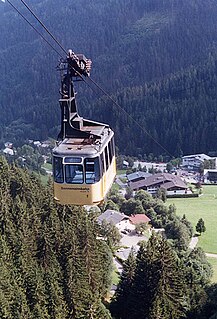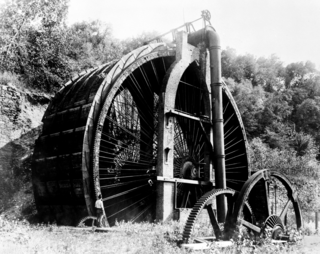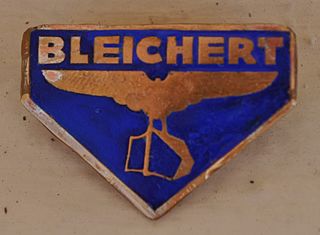In mining history, a Hallidie ropeway is a cable system used to haul ore from a mine, a type of ropeway conveyor.
In mining history, a Hallidie ropeway is a cable system used to haul ore from a mine, a type of ropeway conveyor.
Andrew Smith Hallidie was a Scot who came to America to seek his fortune, with his father, in the goldfields of California. His father had been a blacksmith and an inventor, and had worked with iron rope in Scotland. Not finding much gold, Andrew Hallidie went into the blacksmithing business.
He soon was contracted to build suspension bridges. In the course of his travels around the west, Hallidie noticed that manila hemp rope was being used to haul ore buckets from the depths, with little success as it was subject to weathering and wear. Hallidie turned his bridge experience to building flat, woven iron ropes. These were serviceable and sold well, particularly in the silver mines of the Comstock Lode of Virginia City, Nevada.
About 1867 Hallidie devised an aerial tram to haul ore down mountain sides. An early one was built in Vallejo, Utah. Hallidie's system used one cable to support and haul the buckets, "Curule chair" type towers, bolted brackets and small cubic buckets.
Hundreds of Hallidie Tramways were built in the next 30 years in the US, Mexico, Canada, New Zealand and Japan. Remnants of Hallidie systems can still be found in the Western US.
Edgar Myron Kahn (1940). California Historical Society Quarterly - Andrew Smith Hallidie

A cable car is a type of cable railway used for mass transit in which rail cars are hauled by a continuously moving cable running at a constant speed. Individual cars stop and start by releasing and gripping this cable as required. Cable cars are distinct from funiculars, where the cars are permanently attached to the cable.

Cable transport is a broad class of transport modes that have cables. They transport passengers and goods, often in vehicles called cable cars. The cable may be driven or passive, and items may be moved by pulling, sliding, sailing, or by drives within the object being moved on cableways. The use of pulleys and balancing of loads moving up and down are common elements of cable transport. They are often used in mountainous areas where cable haulage can overcome large differences in elevation.

An aerial tramway, sky tram,cable car, ropeway or aerial tram is a type of aerial lift which uses one or two stationary ropes for support while a third moving rope provides propulsion. With this form of lift, the grip of an aerial tramway cabin is fixed onto the propulsion rope and cannot be decoupled from it during operations.

A gondola lift is a means of cable transport and type of aerial lift which is supported and propelled by cables from above. It consists of a loop of steel wire rope that is strung between two stations, sometimes over intermediate supporting towers. The cable is driven by a bullwheel in a terminal, which is typically connected to an engine or electric motor. It is often considered a continuous system since it features a haul rope which continuously moves and circulates around two terminal stations. In contrast, an aerial tramway operates solely with fixed grips and simply shuttles back and forth between two end terminals.

An elevated passenger ropeway, or chairlift, is a type of aerial lift, which consists of a continuously circulating steel wire rope loop strung between two end terminals and usually over intermediate towers, carrying a series of chairs. They are the primary onhill transport at most ski areas, but are also found at amusement parks, various tourist attractions, and increasingly in urban transport.

A funitel is a type of cableway, generally used to transport skiers, although at least one is used to transport finished cars between different areas of a factory. It differs from a standard gondola lift through the use of two arms attached to two parallel overhead cables, providing more stability in high winds. The name funitel is a blend of the French words funiculaire and telepherique.

Chiatura is a city in the Imereti region of Western Georgia. In 1989, it had a population of about 30,000. The city is known for its system of cable cars connecting the city's center to the mining settlements on the surrounding hills.

A dragline excavator is a piece of heavy equipment used in civil engineering and surface mining.

An aerial lift, also known as a cable car, is a means of cable transport in which cabins, cars, gondolas, or open chairs are hauled above the ground by means of one or more cables. Aerial lift systems are frequently employed in a mountainous territory where roads are relatively difficult to build and use, and have seen extensive use in mining. Aerial lift systems are relatively easy to move and have been used to cross rivers and ravines. In more recent times, the cost-effectiveness and flexibility of aerial lifts have seen an increase of gondola lift being integrated into urban public transport systems.

The Burden Iron Works was an iron works and industrial complex on the Hudson River and Wynantskill Creek in Troy, New York. It once housed the Burden Water Wheel, the most powerful vertical water wheel in history. It is widely believed that George Washington Gale Ferris Jr., inventor of the Ferris wheel, had occasion to observe the wheel while a student at Rensselaer Polytechnic Institute. The iron works site was listed on the National Register of Historic Places as an archaeological site in 1977. The Burden Ironworks Office Building was previously listed in 1972.

The Comstock Lode is a lode of silver ore located under the eastern slope of Mount Davidson, a peak in the Virginia Range in Virginia City, Nevada, which was the first major discovery of silver ore in the United States and named after American miner Henry Comstock.

Andrew Smith Hallidie was the promoter of the Clay Street Hill Railroad in San Francisco, USA. This was the world's first practical cable car system, and Hallidie is often therefore regarded as the inventor of the cable car and father of the present day San Francisco cable car system, although both claims are open to dispute. He also introduced the manufacture of wire rope to California, and at an early age was a prolific builder of bridges in the Californian interior.

The Clay Street Hill Railroad was the first successful cable hauled street railway. It was located on Clay Street, a notably steep street in San Francisco in California, United States, and first operated in August 1873.

Wire rope is several strands of metal wire twisted into a helix forming a composite rope, in a pattern known as laid rope. Larger diameter wire rope consists of multiple strands of such laid rope in a pattern known as cable laid.

Norsjö aerial tramway is a 13.2 kilometre long aerial tramway between Örträsk and Mensträsk in the Norsjö Municipality in Sweden.

Bleichert, short for Adolf Bleichert & Co., was a German engineering firm founded in 1874 by Adolf Bleichert. The company dominated the aerial wire ropeway industry during the first half of the 20th century, and its portfolio included cranes, electric cars, elevators, and mining and ship-loading equipment.

A mine railway, sometimes pit railway, is a railway constructed to carry materials and workers in and out of a mine. Materials transported typically include ore, coal and overburden. It is little remembered, but the mix of heavy and bulky materials which had to be hauled into and out of mines gave rise to the first several generations of railways, at first made of wooden rails, but eventually adding protective iron, steam locomotion by fixed engines and the earliest commercial steam locomotives, all in and around the works around mines.

The Tbilisi cable car crash was an aerial tramway accident in Tbilisi, the capital of Soviet Georgia on June 1, 1990, which resulted in 19 deaths and at least 42 injuries.

The Transylvanian Mining Railway was a local interest narrow-gauge railway which was the first mining railway in Transylvania. This railway was built to ease the transportation of the iron ore mined from the iron ore mines from Ghelari to the blast furnace in Govăjdia and the ironworks from Hunedoara. This railway was also known as the "Hunedoara-Ghelari Local Interest Railway", "CFI Hunedoara", "Mocăniţa Hunedoara", "Calea Ferată Minieră Ardeleană", "Erdélyi Bányavasút" in Hungarian. The line was 10 km (6.2 mi) long from Hunedoara to Govăjdia and another 6 km (3.7 mi) from Govăjdia to Retişoara terminus. This line was used by mixed trains that carried both iron ore and passengers from Ghelari to Govăjdia and Hunedoara's ironworks. They also transported dolomite and limestone from the limestone quarries near Govăjdia to the ironworks.
Ropeway in Nepal, which mainly refers to the aerial ropeways, are used for human and cargo transport. In the ‘Nepal Country Report’ of 1976 by the world bank concluded that construction and maintenance of roads in mountainous are costly due to hilly terrain, and thus other means of transport should be studied mainly indicating to the ropeways. However, ropeways have not gained significant popularity over roadways. In the Ninth Five-year Plan ropeway was encouraged with and involvement of the private sector. But no provision in the national budget was made for ropeway development. Nonetheless, private sector has initiated the construction and operation of ropeways mainly in lucrative places such as religious temple.